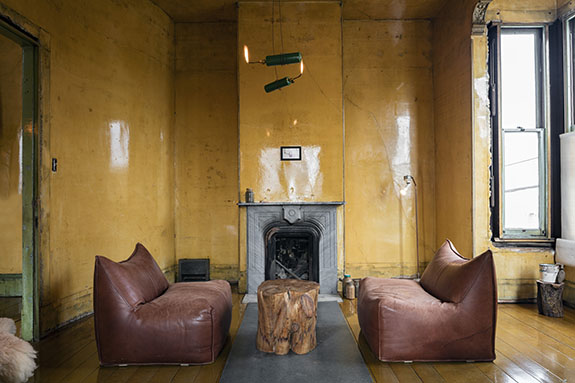 |
.jpg) |
 |
.jpg) |
If theory is based in practice (and I like when it is), then Ireland spent years making a place of his house. He did not, in fact, gut it. Instead, he began revealing its layers of time and history with the skilled hand – and the elbow grease – of a craftsman. The term he preferred – by contrast to renovation – was “stabilization.” He fixed the house, not in time, but in the times of which it was already layered. For example, Ireland peeled away the wallpaper (bits of which he kept in a glass jar), revealing strata of other wallpaper, wood lath and plaster, as well as gouges, in-fills, scuffs, and repairs made a century before. These were his decorative patterns – the marks of making and remaking. Everything that was originally covered he uncovered, exposing the inside of the house to the generous and ever-changing daylight surrounding it, and, at night, to the shadow play within. Any changes he made to the structure – replacing crumbling plaster with modern plasterboard, for example – were not blended with the original wall, but set crisply apart by precision of cut (modern geometry) and reflectiveness of (urethane) finish. Look closely at a doorjamb and you will see exposed two or three decisions made between 1886 and whenever Ireland sealed it with varnish. One may also notice old door openings filled with off-color plaster, names and phone numbers (FOXY – 621-3479) penciled in tiny letters on the wall (near a crack), a gouge in the plaster commemorated by a tiny bronze plaque (THE SAFE GETS AWAY FOR THE SECOND TIME NOVEMBER 5, 1975), molding removed from around the windows revealing their original rough cutouts, and diagonal stress cracks in a white plaster wall (maybe from 1906 – who knows?). The house is a record of its own making, and remaking.
 |
 |
That’s very insightful with great personal angle. Perfect….
Thanks. Great shots too! Also like your photos work.
Thanks. Great shots too!
This well written article should be in Art History books.
Thanks for the compliment.
Jeff,
This is a magnificent song about Capp Street and David Ireland… Thank you!
Thank you. It’s nice to know the writing gets so closely read.